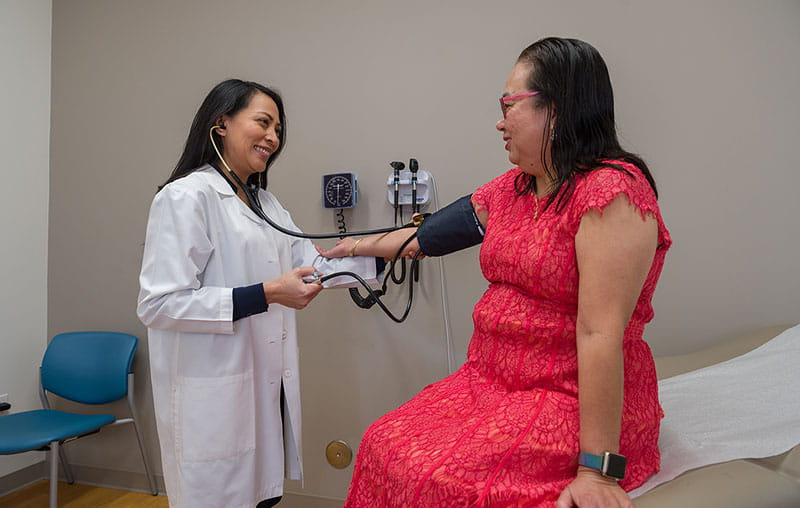Neck stiffness is common. Maybe you’ve been putting up with it for a while, since it seems to come and go. But lately it has become chronic pain and you realize you can’t really turn your head. You finally make that appointment – and the doctor recommends surgery.
Don’t put off seeing a professional
University Health physical therapist Mark Linkinoggor has worked with many patients before, after and instead of surgical intervention. His first piece of advice for people with chronic pain is not to wait.
“Addressing things early rather than waiting will make a big difference in your outcome, whether you have surgery or not,” Linkinoggor said.
For the person with neck pain and stiffness, he said, waiting too long could lead to the need for surgery to perform a neck fusion, where some bone is removed to ease pressure on the spinal cord and other bones are fused together – for example, the C4 and C5 vertebrae.
The resulting fusion will hold those bones together. The body compensates for the lack of movement at that particular point by moving more in other areas. However, Linkinoggor said, this can lead to other chronic problems.
But if the spinal cord is not yet compromised, surgery may not be necessary. Linkinoggor laid out the questions he most often hears – and suggests an edit to that list.
Common Questions
- What’s wrong with me?
- What are you going to do to fix it?
- How long will it take to recover?
The “What are you going to do?” question, Linkinoggor suggests, would be better asked as “What are my options?”
This is crucial, he said, because sometimes patients don’t get all the options, including nonsurgical options, when they get their diagnosis.
They also may not get a full explanation of the recovery process, and they may be surprised and disappointed to experience a slow recovery, with sensory changes, pain or loss of muscle function.
What does recovery look like?
There are many factors to account for when estimating what recovery from surgery would look like, he said, starting with the social determinants of health. These are the nonmedical factors that influence a person’s health, such as the conditions in which they are born, grow, work and live, including social networks and education levels.
“Social determinants of health are some of the strongest predictors of how things are going to go for a patient after one year, three years, five years,” Linkinoggor said. If a person has low health literacy, low education, transportation issues and/or other conditions in their environment that challenge their functioning and quality of life, they are likely to have a harder time recovering.
Physical therapy before surgery
Another big factor in a person’s recovery is their overall health – and personal agency has a lot to do with this. In this case, he said, the physical shape you’re in going into surgery is also a major determinant of your outcome.
To be in the best condition possible, some will do physical therapy before surgery to prepare to come through it better and ease the healing process.
“Physical therapy – ‘prehabilitation’ – is usually very effective in preparing a person for surgery. The better condition one is in before surgery, the better the surgical outcome will be,” Linkinoggor said. “This is largely underutilized nationally and internationally.”
Because it’s not often considered, prehabilitation would be something to bring to the conversation with your doctor about surgery and nonsurgical options.
It’s a good idea to write out your questions to the doctor before going in and take the written notes for reference.
More questions to ask
- What are the risks and benefits of surgery compared to physical therapy?
- What have you seen in terms of patient response to this intervention?
- How many of these procedures have you done/how often do you do them?
Linkinoggor noted that the more procedures a physician has done, the more comfortable they are going to be with your particular case, and the more thoroughly they can discuss the other questions.
Understand your insurance
One key area that patients should be prepared to navigate is health insurance coverage, Linkinoggor said. This can require patience. If you want to explore physical therapy, depending on your insurance coverage, sometimes the specialist can make the referral. But you may need to go back to your primary care physician for another referral.
Imaging doesn't always reflect what you feel
X-rays and MRIs are important diagnostic tools, but Linkinoggor warns against relying on them completely to decide a course of treatment. What you’re actually feeling could be very different.
“You could have abnormal imaging findings and no pain. You could have normal imaging and pain,” he said. “There’s a saying: ‘Treat the man, not the scan.’”
“A lot of patients will say, ‘My doctor says my knee is bone on bone. How are you going to address it?’” he said. But they may not actually be experiencing that much pain.
“Imaging findings don’t always correlate to clinical presentation,” Linkinoggor said.
Either way, it’s up to you
Whether you choose surgery or an alternative, it’s key to be committed to doing your part in order to see results. Keeping appointments and sticking to the prescribed at-home exercises – often for months at a time – are important for a full recovery.




